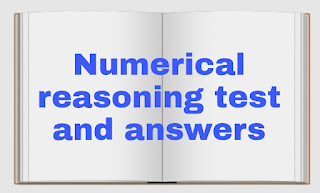Numerical reasoning test and answers
Numerical Reasoning Test:
Question 1:
If a shirt originally costs $50 and is discounted by 20%, what is the final price?
A) $30
B) $35
C) $40
D) $45
Question 2:
The average of five numbers is 12. If four of the numbers are 10, 12, 15, and 18, what is the fifth number?
A) 10
B) 12
C) 15
D) 20
Question 3:
A car is traveling at a speed of 60 miles per hour. How many kilometers will it travel in 2.5 hours? (1 mile = 1.609 kilometers)
A) 96.45 km
B) 120 km
C) 160.9 km
D) 241.35 km
Question 4:
A company sells a product for $80 per unit. If the cost of producing one unit is $50, what is the profit percentage?
A) 25%
B) 37.5%
C) 40%
D) 60%
Solutions:
Question 5:
Discounted price = Original price - (Original price * Discount percentage)
Discounted price = $50 - ($50 * 0.20) = $50 - $10 = $40
Answer: C
Question 6:
Total sum of five numbers = Average * Number of numbers
Total sum of five numbers = 12 * 5 = 60
Fifth number = Total sum - Sum of four known numbers
Fifth number = 60 - (10 + 12 + 15 + 18) = 60 - 55 = 5
Answer: Not listed (the fifth number is 5)
Question 7
Distance in kilometers = Speed in miles per hour * Time in hours * Conversion factor
Distance in kilometers = 60 * 2.5 * 1.609 = 241.35 km
Answer: D
Question 8:
Profit per unit = Selling price - Cost price
Profit per unit = $80 - $50 = $30
Profit percentage = (Profit per unit / Cost price) * 100
Profit percentage = ($30 / $50) * 100 = 60%
Answer: D
Question 9
A store sells a product for $120, which includes a markup of 20% on the cost price. What is the cost price of the product?
A) $90
B) $100
C) $105
D) $110
Question 10:
If the ratio of boys to girls in a class is 3:5 and there are 40 students in total, how many boys are there?
A) 9
B) 12
C) 15
D) 18
Question 11:
The population of a city increased by 10% in the first year and decreased by 5% in the second year. If the initial population was 200,000, what is the population after two years?
A) 199,000
B) 202,000
C) 207,000
D) 210,000
Question 12:
A rectangular field has a length of 80 meters and a width of 60 meters. If the field is divided into smaller squares with sides measuring 10 meters, how many squares are there in total?
A) 40
B) 48
C) 60
D) 64
Solutions:
Question 5:
Let the cost price be C. Given that the markup is 20%, we can write the equation as:
Selling price = Cost price + (Markup percentage * Cost price)
$120 = C + (0.20 * C)
$120 = C + 0.2C
$120 = 1.2C
C = $120 / 1.2 = $100
Answer: B
Question 13:
Let the number of boys be 3x and the number of girls be 5x. The total number of students is 3x + 5x = 8x.
Given that 8x = 40, we can solve for x:
8x = 40
x = 40 / 8 = 5
Number of boys = 3x = 3 * 5 = 15
Answer: C
Question 14:
After the first year, the population increases by 10%, so the population becomes 200,000 + (0.10 * 200,000) = 200,000 + 20,000 = 220,000.
After the second year, the population decreases by 5%, so the population becomes 220,000 - (0.05 * 220,000) = 220,000 - 11,000 = 209,000.
Answer: Not listed (the population is 209,000)
Question 15
The total number of squares is equal to the total area divided by the area of each square. The total area is the length multiplied by the width, which is 80 * 60 = 4800 square meters.
The area of each square is 10 * 10 = 100 square meters.
Total squares = Total area / Area of each square = 4800 / 100 = 48
Answer: B
Conclusion
That concludes the numerical reasoning test. I hope you found it helpful and challenging. Numerical reasoning tests are designed to assess your ability to work with numbers, analyze data, and make logical deductions. Practicing such tests can help improve your numerical skills and prepare you for similar assessments. If you have any more questions or need further assistance, feel free to ask.

Post a Comment